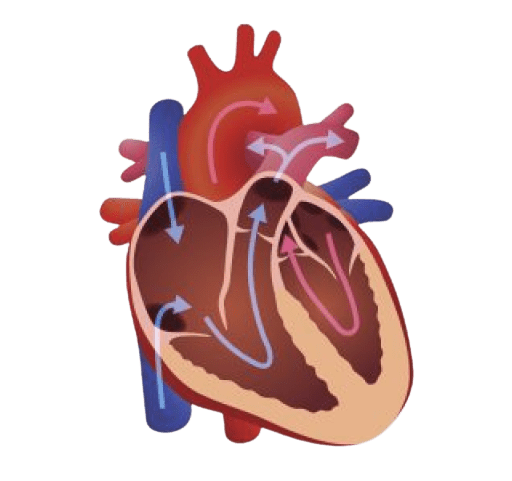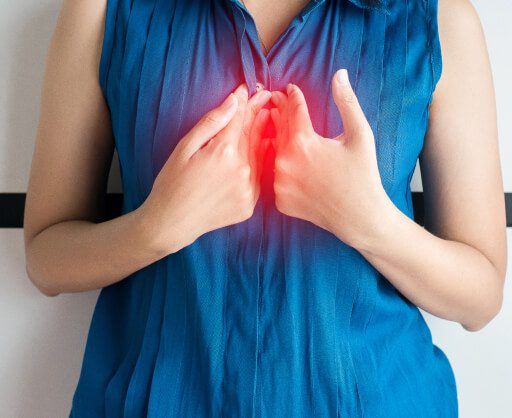What is Heart Valve Disease?
Heart valve disease is when one or more of the valves in your heart become diseased or damaged, preventing them from opening or closing properly. This can affect the ability of your heart to pump blood effectively.
The burden of heart valve disease is rising as a consequence of our ageing population and increased life expectancy. About 1 in 40 adults in the general population are affected and this rises to over 1 in 10 in those over the age of 75 years. This means that heart valve disease is as common as heart failure, yet this is not widely appreciated.



How Does Your Heart Work?
Your heart is the muscle that pumps blood around the body, and it is located in the left side and centre of the chest cavity. The blood carries oxygen and nutrients to the cells and collects waste products for removal.
The heart consists of specialised muscle and it has two sides, left and right, separated by a wall. Blood coming back from the body tissues (collections of cells) enters the right side of the heart. From there the heart pumps the blood to the lungs where the carbon dioxide is removed and the blood picks up oxygen from the inspired air. The oxygen-rich blood then travels to the left side of the heart and out to the body organs through the aorta, which is the largest artery in the body.
What happens in your heart when you have Heart Valve Disease
These valves can be diseased or damaged and can affect the flow of blood in 2 ways:
The valve area can become narrowed, not opening fully and causing an obstruction or blockage to the flow of blood. This is called valve stenosis. This can put extra strain on your heart, as it has to pump harder to force the blood past the narrowing.
The valve may not close properly, allowing blood to flow backwards in the wrong direction. This is called valve regurgitation or incompetence. This can put extra strain on your heart as it has to pump harder to get the necessary amount of blood through your heart.


What causes
Heart Valve Disease
The main causes of heart valve disease are:
- Abnormalities that are present at birth (congenital heart disease)
- e.g. aortic valve stenosis in people with 2 instead of 3 cusps in their aortic valve
- A previous infection
- rheumatic fever (an inflammatory reaction on the heart valves that can occur after a “strep throat”)
- endocarditis (a bacterial infection that lodges in and damages the heart valve, typically the mitral or aortic valves)
- Cardiomyopathy – a disease of the heart muscle which enlarges the heart chambers
- Damage to the heart muscle from coronary heart disease and a heart attack
- Ageing (wear and tear)
What are the symptoms of Heart Valve Disease?
Some people with heart valve disease will experience no symptoms for many years. Some common symptoms people may experience include:
- shortness of breath, particularly after physical activity or when lying down
- swelling of the ankles and feet
- feeling excessively tired
- dizziness or fainting
- irregular heart beat
- chest pain or tightness
Frequently, symptoms can worsen gradually over time, making it important to track any changes you may notice.
Feeling older than your age or finding it hard to keep up? Think HEART VALVE DISEASE!
How is Heart Valve Disease Diagnosed?
You may be seeing your doctor because you have noticed some symptoms or you may not have any symptoms but your doctor has heard a murmur when routinely examining you. When your doctor auscultates or listens to your heart with a stethoscope and can hear the blood whooshing or clicking as it flows from one chamber to another, it is called a heart murmur.
A murmur does not always mean that there is a problem with your heart as people with normal hearts may also have murmurs. These are called innocent murmurs. They can be common during childhood and often disappear by adulthood. The murmur may also occur if blood moves rapidly through normal valves. This can happen with fast heart rates that can occur in pregnancy, with a fever, with an overactive thyroid or with anaemia.
You may then have to have some further tests to check your valves and your heart function. These include:


Echocardiogram: an echocardiogram is a simple ultrasound scan that uses sound waves to produce a video image of your heart. It can show if you have had any previous heart attacks or if the heart valves have been damaged in any way. It also measures your ejection fraction which is the amount of blood that can be pumped out of your heart every time it beats. This helps to tell how well your heart is pumping.
Exercise Stress Test: an exercise stress test involves exercising on a treadmill or a stationary bicycle. This test determines how well your heart responds to exercise and can provide valuable information in patients who have little or no symptoms or where symptoms are difficult to assess.
There are many other different tests your doctor may suggest to find out how your heart is doing.
Chest X-ray: a chest X-ray shows if your heart is enlarged and whether or not there is any build-up of fluid around the lungs.


How is Heart Valve
Disease Treated?
Increased awareness and early detection of this condition can mean heart valve disease is entirely treatable.
Many people with heart valve disease can live a normal life for many years, with little treatment. Treatment depends on which of the valves is affected, the severity of your condition and if it is getting worse. Sometimes even if you don’t have symptoms or if they seem mild, your doctor may still recommend treating your condition as your heart may be showing signs of strain. Treatment would aim to protect your heart from further damage.
The main treatment options are:
- to help you manage symptoms
- to reduce your risk of a blood clot developing on the surface of mechanical valves
- The diseased or damaged valve may be repaired using a ring to support the damaged valve. This method is more often used for the mitral or tricuspid valves.
- The entire valve may be removed and replaced. The replacement valve can be either mechanical or made of animal tissue.
- TAVI is a less invasive approach which allows the replacement aortic valve to be inserted via a catheter usually through a small incision in the groin.
- This procedure is carried out in a specialised laboratory and typically lasts up to one hour.
- TAVI is suitable for patients who are considered at higher risk for valve surgery.
Are there any complications?
The chances of developing heart valve disease increase with age. If promptly diagnosed and treated with valve replacement or repair, you can return to a good quality of life and enjoy the Power of Positive Ageing. As with any heart condition there are potential complications, including:
- Heart failure
- Stroke
- Blood clots
- Heart rhythm abnormalities

